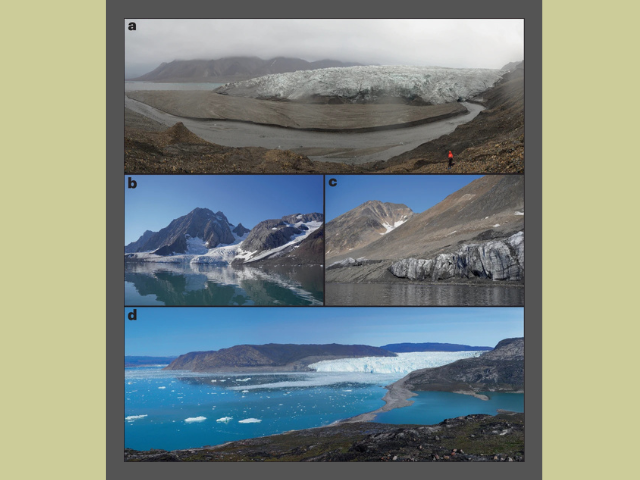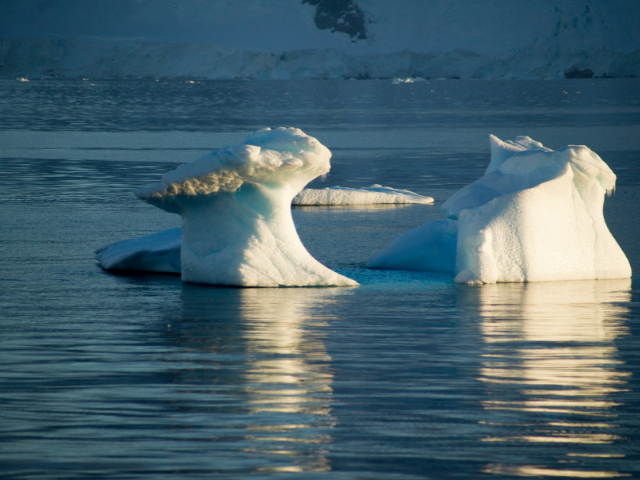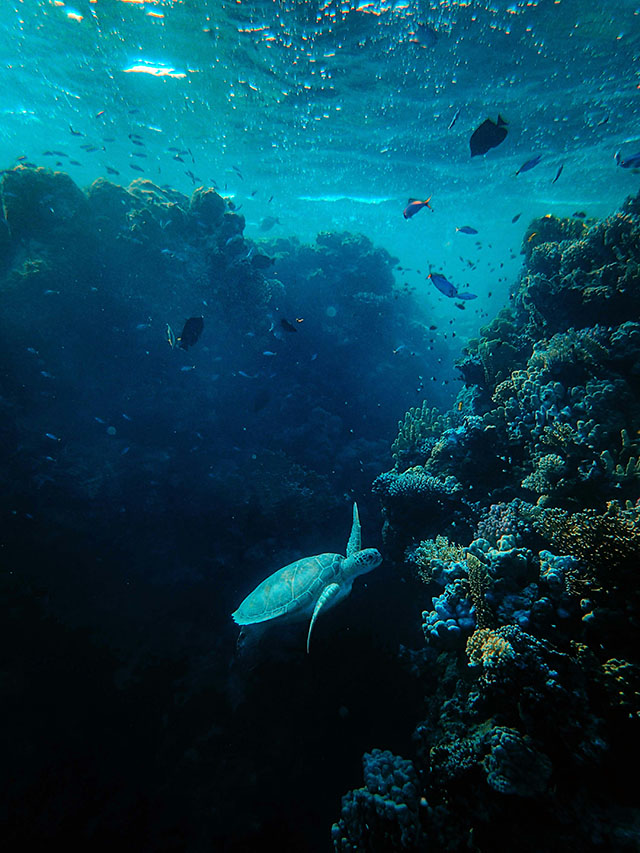
Geodiversity of new coastlines developed after retreat of Arctic marine-terminating glaciers. a, Young delta system accumulated in the lagoon exposed by Recherchebreen, Svalbard. b, Rocky cliffs and morainic cliffs released from retreating Samarinbreen, Svalbard. c, Juvenile beach system in Brepollen supplied by glacial sediment dropping from remnants of ice cliffs. d, Erosion of a lateral moraine by calving waves from Eqip Sermia, Western Greenland, leading to extension of the spit system along the southern coast. Credit: b,c, Aleksandra Osika. Nature Climate Change (Nat. Clim. Chang.) ISSN 1758-6798 (online)
A Changing Arctic
Over 2,400 kilometers of new Arctic coastline have appeared in just 20 years.
That’s like adding a whole new stretch of shore equal to the length of the U.S. West Coast — all because of melting glaciers. As temperatures rise across the globe, nowhere is changing faster than the Arctic. In fact, the Arctic has warmed nearly four times faster than the rest of the planet in the past few decades.
And with that warming comes dramatic change: the disappearance of ice, the reshaping of coastlines, and the emergence of land that hasn’t seen the light of day for thousands of years.
Why Glaciers Matter
Let’s start with the basics. Some glaciers, called marine-terminating glaciers, end in the ocean instead of on land. These icy giants slowly move downhill and, when they meet the sea, they break off chunks of ice into the water — a process known as calving.
But as the planet gets warmer, these glaciers are shrinking. Warmer air and ocean water are causing them to melt and pull back from the coast. When they do, they uncover land that used to be buried under thick ice.
This retreat is happening all over the Northern Hemisphere — from Alaska to Greenland — and it’s changing what our maps look like.
What Happens When Glaciers Retreat?
When a glacier melts and retreats, it exposes new ground beneath it. That newly uncovered area often becomes coastline, especially when the glacier used to flow into the ocean.
These brand-new coastal areas are made of soft sediments like sand and gravel, or sometimes smooth, polished rock. Because this land has been hidden under ice for so long, it hasn’t had time to settle or stabilize. That means it can be quickly reshaped by wind, waves, and weather.
Scientists call these places “paraglacial coasts” — a term that simply means land newly exposed by melting glaciers. These coasts are among the most dynamic and fast-changing landscapes in the world.
Where Is This Happening?
Between 2000 and 2020, researchers tracked over 2,466 kilometers of new coastline created by glacier retreat.
Here’s where the biggest changes are:
- Greenland: 66% of the new coastline came from here — over 1,600 km.
- Northern Canada, Russia, and Svalbard: Each contributed around 9–10% of the new coastlines.
- Alaska and Southern Arctic Canada: Though smaller in size, these areas had some of the most efficient coastline formation per glacier.
This isn’t just about flat beaches — new islands are also appearing. In fact, 35 new Arctic islands were identified between 2000 and 2020, most of them in Greenland.
Why This Matters to People and Nature
New coastlines might sound exciting — and they are — but they come with both risks and opportunities.
Risks
- Tsunamis and landslides: Some new coasts are unstable and prone to large waves caused by landslides, falling icebergs, or glacier collapse. A tragic example happened in Greenland in 2017, when a tsunami destroyed homes and took lives.
- Tourism safety: Melting glaciers change the landscape rapidly, affecting local communities and visitors who camp or sail near them.
Opportunities
- New habitats: As glaciers melt, they make room for new ecosystems. Plants, animals, and even fish begin to move in and adapt to these fresh environments.
- Natural resources: Some of the newly exposed land is rich in materials like sand and gravel, which could be valuable for local economies, especially in Greenland.
What’s Next?
Glaciers are expected to keep retreating as global temperatures rise. That means even more coastlines and islands will appear in the coming decades. But this change isn’t always predictable. Some glaciers move slowly, while others retreat in big bursts. And the way the land responds depends on things like the type of rock, the presence of permafrost (permanently frozen ground), and the local climate.
Scientists emphasize the importance of monitoring these new areas closely. Understanding how they’re forming — and how fast — helps us prepare for what’s ahead, from rising sea levels to new environmental challenges.
What You Can Do
Even if you’re far from the Arctic, there are still ways you can make a difference.
- Read and share reliable information about changes happening in the Arctic and around the world.
- Organizations and scientists are doing amazing work using satellite data and field studies. Supporting or sharing their findings helps spread awareness.
- Advocate for climate action, including clean energy and reduced carbon emissions, to help slow ocean warming.
- Vote for leaders and policies that take action on climate change.
- Hold your local, state, and national elected officials accountable for taking climate action and protecting our water, air, and health.
Closing Thought
The Arctic is not a frozen, unchanging place — it’s alive, moving, and reacting to what we do. The more we understand these changes, the better we can care for our planet.
Source: Kavan, J., Szczypińska, M., Kochtitzky, W., Farquharson, L., Bendixen, M., & Strzelecki, M. C. (2025). New coasts emerging from the retreat of Northern Hemisphere marine-terminating glaciers in the twenty-first century. Nature Climate Change. https://www.nature.com/articles/s41558-025-02282-5?error=cookies_not_supported&code=f344f836-da9d-42a2-a92b-a8105f50fedb.


